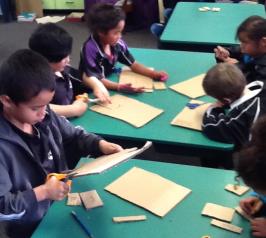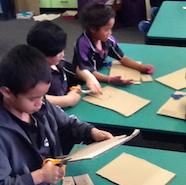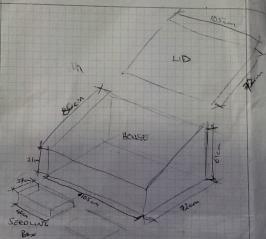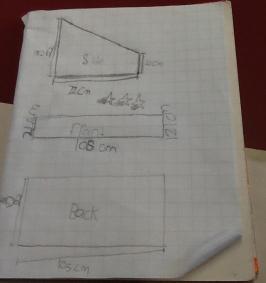Exploring modelling in practice and materials: Creating a shade house
Teaching inquiry
How can I develop students’ understandings of modelling in technological practice and in technological knowledge as we design and build a shade house?
Could this project also provide opportunities for teaching technological products and integrating understandings in mathematics?
Introduction
At Te Kura o Otangarei, teacher Ngapoko Ashford found that her shade house unit helped students to:
- grow their understandings of modelling within practice
- begin to build understandings of the technological modelling component within the technological knowledge strand
- integrate their learning in technology, geometry, and mathematics.
This snapshot is a good example of local curriculum design and assessment for learning.
Background
The students in room 2 at Te Kura o Otangarei, Whangarei decided with their teacher Ngapoko Ashford that they would build a shade house to support the glass house built by the senior school. Room 2 had noticed that there was nowhere for the seedlings in the glass house to transition to before planting out. This is an authentic context taking into account the needs of the end user and the seedlings.
Planning
Technological modelling
Ngapoko thought that this project could be a vehicle for beginning to build understandings in the technological modelling component of the technological knowledge strand. Technological modelling supports students to critically evaluate their design's fitness for purpose. The teacher guidance in the indicators of progression provided a particular focus.
The teacher guidance given for technological modelling at level one is:
“To support students to develop understanding of technological modelling at level 1, teachers could:
- provide students with the opportunity to discuss why technological modelling is important to the development of technological outcomes and that it involves both functional modelling and prototyping
- guide students to identify that functional models are representations of potential technological outcomes and that they exist in many forms (for example, thinking, talking, drawing, physical mock-ups, or computer aided simulations)
- provide students with the opportunity to discuss that design concepts includes design ideas for parts of an outcome, as well as the conceptual design for the outcome as a whole
- provide students with the opportunity to interact with a variety of functional models and guide them to identify that the purpose of functional modelling is to test design concepts to see if they are suitable for use in the development of an outcome.”
Indicators of Progression, Achievement Objectives, Technological modelling, level 1
Outcome development and evaluation
Ngapoko could also see that the project would provide opportunities for growing understandings in the outcome development and evaluation component of the technological practice strand, with a focus on modelling.
At level one, the following teacher guidance is given for outcome development and evaluation:
“To support students to undertake outcome development and evaluation at level one teachers could:
- provide opportunities to develop drawing and modelling skills to communicate and explore design ideas. Emphasis should be on progressing 2D and 3D drawing skills and using manipulative media such as plasticine, wire, or card.”
Indicators of Progression, Achievement Objectives, Outcome development and evaluation, level 1
Introducing the unit
To stimulate the students thinking around how to describe a technological outcome, Ngapoko had the students examine a chair in the classroom and describe its attributes.
She introduced the word function and asked the students to give her words that described the function of a chair. The students described the function of the chair as something to “sit on” and “stand on”.
Modelling
Ngapoko could see that she would also need to teach the students about measurement and geometry to support them to model their outcomes both in a 2D and 3D format.
The students planned to use the glasshouse as a model for the shade house so they measured the glasshouse and looked at how it was built.
The students discussed their ideas for the shade house. Ngapoko documented these on the white board as sketches. As she drew the sketches, she discussed with the students what parts of the shade house would go where and how to show this in their drawing.
Paul Neveldsen, Beacon practice facilitator, visited during this time and taught the students how to draw the individual components of the shade house.
Each student then drew his or her idea for a shade house using a mathematics grid-lined exercise book. They labeled the parts to complete their 2D models.
The students then transferred the measurements from their 2D models onto corrugated card, cut the individual components out, and assembled a 3D model of the shade house.
The students could readily see that the purpose of the model was to test that the idea worked – that the purpose of functional modelling is to test design concepts to see if they are suitable for use in the development of an outcome.
The students noticed that attaching the pieces with masking tape wasn’t stable enough – and this led them to the understanding that the shade house would need a frame inside, otherwise “it will wobble too much”.

The importance of accurate measuring became very apparent as they attempted to assemble their corrugated card models.
Materials
Learning in the context of materials (technological area designing and developing materials outcomes), there were opportunities for growing understandings within the technological products component.
The students noted:
"We can’t make it out of cardboard because it’s too soft and won’t work … it won’t be strong enough in the rain and wind … the cardboard will go soft and breakdown and rot and blow away."
Ngapoko talked to the students about suitable materials and explained that she planned to recycle some wooden crates to make the shade house. The students also talked about the best covering to use. The senior students had faced problems with vandalism of the plastic covering on the glasshouse – the lid had been slashed leaving gaping holes. The students agreed that chicken wire covering the shade cloth would prevent this.
All of the students had a turn at different parts of the construction of the shade house. They used recycled pallets – pulled the nails out, sawed the wood into the required lengths, and constructed the shade house.
There were further discussions on materials when they changed the nails from brights to galvanised nails to withstand the outdoor conditions. The class was shown how to add a crossbar to keep the framework square and add strength. The shade house was painted to protect the untreated wood. Ngapoko noted in hindsight that it would have been easier to paint the pieces of the shade house before construction to ensure complete coverage. The student’s understandings of materials developed as these issues were resolved.
Reflective writing
The students wrote about the process of making the shade house and presented this as a class at assembly. This became an exercise in reflective writing and constructing text with an awareness of the audience.
Reflective writing informs learning progression because the audience provides a purpose and focus for the development of the shade house. This is a good example of assessment for learning.
Outcome
The students demonstrated good understanding of 2D and 3D modelling within their technological practice of creating the shade house.
They could also see that functional modelling tested design ideas.
Their understandings within technological products grew as they identified the materials in the shade house and the performance properties of these – including the wood, nails, paint, chicken wire, and shade cloth.
What next?
Ngapoko plans to focus on prototypes in her next unit of work on technological modelling. This aspect was not a focus of the shade house project.
On reflection, there were also opportunities to discuss the materials used in the glasshouse and why these were different to those used for the shade house. This could have added to the student understandings of materials within the technological products component.
In next steps with this class, Ngapoko could build on the students’ understandings of technological modelling by providing them with a range of functional models to interact with and explore.



